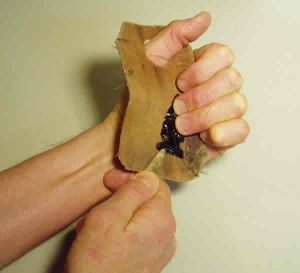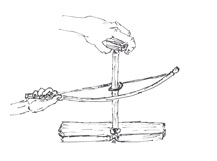In this day of hectic life and massive technology overload, many people find relief looking back to their cultural heritage, ancient coins or even archaeology. Old is interesting.
One area of growing interest is Primitive Skills, learning how one can live off the land as did our far distant ancestors. My own interest in archaeology and ancient Native American life lead me to spend several weeks in various Skills classes, schools and gatherings. One thing I discovered was that there is not very much “primitive” in Primitive Skills.
Most early societies were hunter/gatherers, heavy on the gathering. These First Peoples would need to not only know which plants were eatable or poisonous, but also their seasonal availability. One example is Camus root (1). This plant was harvested in the autumn by early northwest Native Americans, but has a toxic look-alike, unsurprisingly called Death Camas (2). Differentiating these two plants would test the knowledge of any modern day Biologist. Although I know that, side by side, the Camas leaves have a more prominent leaf ridge and the Death Camas leaf is smoother, I’m not about to dig up its bulb without a guide book with lots of pictures. Being wrong is being dead wrong.
Various plant products could also be medicinal, from pain relief to antibacterial properties. One well-known example is the bark of the Willow tree, used for the reduction of pain and fever. Aspirin was one of the first modern days pharmaceuticals made from a common plant source. Nowadays, large drug companies routinely send PhD researchers into “wild” places to try to re-discover ancient sources of medicine. My skill in pharmaceuticals is limited to using crushed Curly Dock (3) for skin rashes resulting from accidentally walking through a patch of Stinging Nettles.
Weapons would be needed for hunting animals as well as to defend reliable foraging territories. One such early weapon was the atl-atl (4), or spear thrower. This tool is a forearm long shaft grasped at one end and hooked at the other, and is used to “throw” a long flexible dart, or lightweight spear.

The extra leverage during the throw increases the velocity of the dart. The physics of the energy loading of this flexible spear has only recently been studied (5). As for my skills at hunting with the Atl-atl and dart, it’s good that my family is not depending on me to bring home a Wooly Mammoth for dinner.
Providing a projectile tip for the atl-atl dart, or even for a simple knife-edge, is a rightly refined technology in itself. Not any rock can be broken into sharp edges, and very few of those are suitable to be thinned and sharpened by knapping (6), or pressure flaking. Years of practice are required to proficiently produce projectile points, knifes or scrappers. I can usually produce a tip or knife with a few hours work, but the results are erratic and lots of good rock wasted.

Rock before (left hand holding obsidian, right hand holding a hammer stone)

Rock after (left hand holding obsidian point, right hand holding antler pressure tool)
Once one had mastered the rather refined skill of acquiring animal protein and edible plants, the next step is starting a fire. Cooked food, likely an accidental byproduct of a lightning strike, made survival easier by increasing the digestibility of complex carbohydrates and proteins (7). But lightning strikes are not reliable and certainly not safe. A separate accidental observation provided the clue to a safer method. Perhaps wanting a hole in his/her favorite walking stick or ornament, an enterprising ancestor used a rapidly rotating wood “drill”. Someone noticed that the resultant hot wood dust produced a glowing ember. This was then refined into a reliable method of fire production (8).

Work equals heat, as taught in college Physics classes. And our pre-historic ancestors put this in daily practice.
As with any subject of learning, the more I know, the more I realize how much I don’t know. The only thing “primitive” about ancient primitive skills is the level of a typical modern man’s understanding of those skills used by our ancestors in their daily life.
1. Jim Pojar and Andy MacKinnon, Plants Of The Pacific Northwest Coast: Washington, Oregon, British Columbia & Alaska, (Lone Pine Publishing, Revised Edition, 2004), page 108
2. Pojar, Plants Of The Pacific Northwest Coast: Washington, Oregon, British Columbia & Alaska, page 109
3. http://www.voyageurcountry.com/htmls/floweringplants/plants/dockcurled.html
4. http://www.hollowtop.com/atlatlbob.htm
5. http://www.atlatl.com/mechanics.html
6. John C. Whittaker, Flintknapping, Making & Understanding Stone Tools (University of Texas Press, 1994)
7. http://en.wikipedia.org/wiki/Cooking
8. http://www.natureskills.com/bow_drill_fire_making.html
* * *
